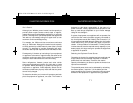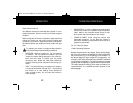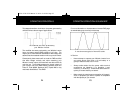
13
BATTERY/CABLE INFORMATION
• It may be advisable to operate the inverter from a bank
of batteries of the same type in a "parallel" configura-
tion. Two such batteries will generate twice the
amp/hours of a single battery; three batteries will gen-
erate three times the amp/hours and so on.
This multiple parallel battery option is especially re c-
ommended for the WHISTLER 2000 series inverter due
to the high level of amps this model re q u i r es to pro-
duce up to 2750 watts of continuous load. For more
i n f o r mation re g a rding battery power please visit our
i n v e r ter faq page at www. w h i s t l e rg ro u p . c o m / f a q - i n v e rt-
e r s . a s p .
Wi r e Cable Gauges
For safe and proper operation of the invert e r, connect the
i n v e r ter to the power source with the thickest wire available
and in the shortest length practical.
1000 Series
When the inverter and the battery are set up within four feet
of each other, use a minimum of #4 gauge wire to make the
connections. Within four to six feet, use a minimum of #2
gauge wire. At distances of more than six feet, use #0 gauge
w i re .
BATTERY INFORMATION
12
1. To calculate the amp/hour of the battery, first determ i n e
its "re s e rve minutes" rating. (Deep cycle marine batter-
ies generally have the highest re s e rve minute ratings).
This rating typically is marked on the battery along with
the "Cold Cranking Amps" (CCA) rating. Multiply the
re s e rve minutes rating of the battery by 0.3 to determ i n e
the battery amp/hour rating of 50 (166 x 0.3 = 49.8).
2. To estimate the maximum battery power the inverter will
re q u i r e to run a piece of equipment or appliance, divide
its continuous load wattage re q u i rement by 10.
The WHISTLER 1000 watt model utilizes 50 amps of bat-
t e ry power to operate an appliance with a 500 watt con-
tinuous load re q u i rement. (500 divided by 10 = 50).
3. Conclusion: The re s e rve power of the battery is suff i-
cient to satisfy the continuous load demand placed on
the inverter for a maximum of about one hour. (49.8
divided by 50 = 1 hour).
N o t e :
• When the inverter will be operating equipment or appli-
ances with high continuous load ratings for extended
periods, it is not advisable to power the inverter with the
same battery used to power your vehicle. If the car or
t r uck battery is utilized for an extended period, it is pos-
sible that the battery voltage may be drained to the
point where the battery has insufficient re s e r ve power to
s t a rt the vehicles.
1250/1750/2750 Manual 3/6/02 2:45 PM Page 15


















